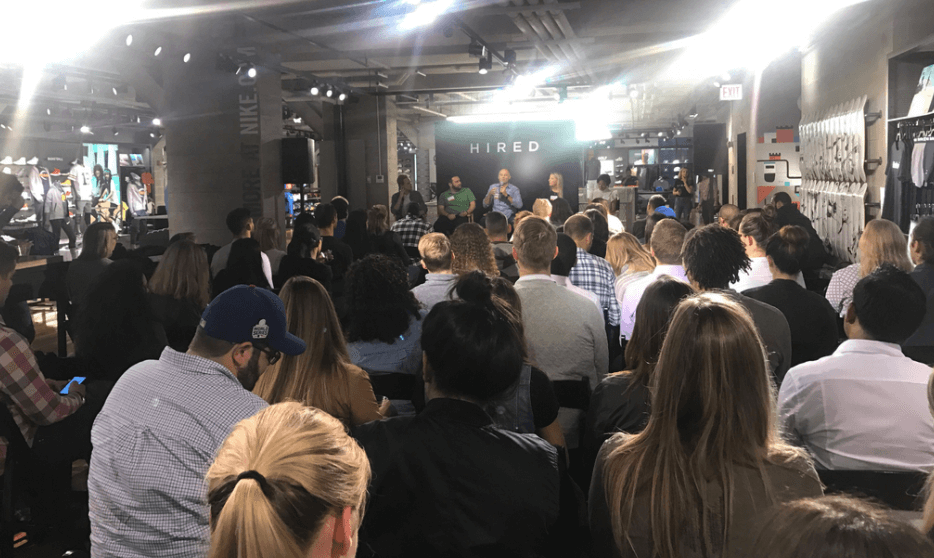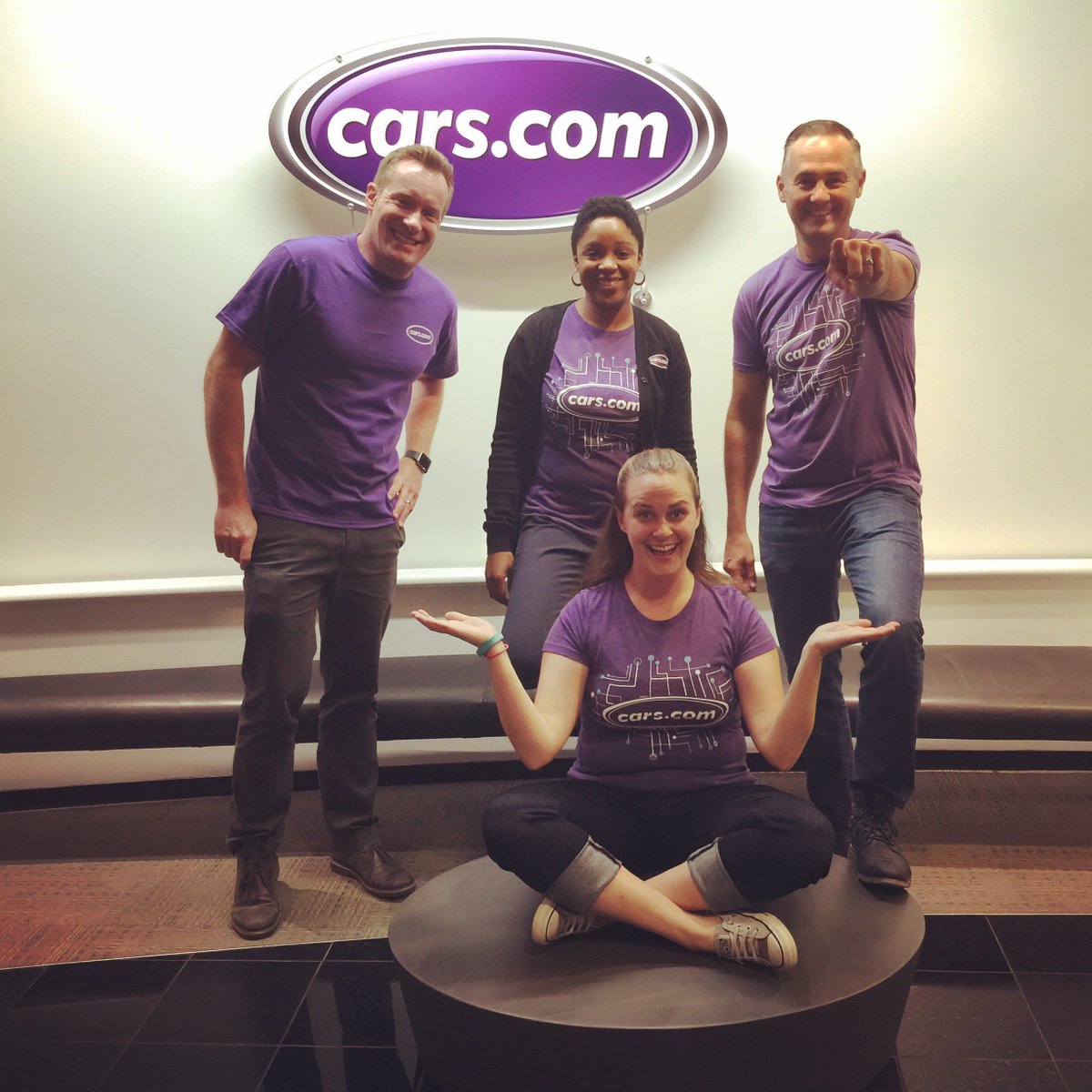
Chicago Talent Leaders On Hiring Funnel Optimization, Metrics, and Recruiting Culture
In our never-ending mission to spread the good word of talent acquisition far and wide, your friends at Hired gathered our favorite 100 Chicago recruiters at the Michigan Avenue Nike store for an evening of bacon-wrapped dates, craft cocktails, and recruiting expertise. The Windy City– so named not for its weather but rather the blustering, meaningless drivel spouted by its many attorneys–is home to a great many amazing talent acquisition pros, and while the lawyers who earned the city it’s moniker may have been full of it, our friends on the hiring side clearly know their biz. After the attendees made use of their complimentary $100 Nike gift cards, we settled in for a panel discussion lead by some truly great Chicago talent leaders. Eat your heart out, Lollapalooza. Here’s our lineup:
Jim Conti, Director of Talent, Sprout Social.
Mike Dwyer, Director of Talent & Employer Brand, Cars.com
Amy Cwalina, Talent Acquisition Manager, Uptake
Stacey Kraft, Global Head of Talent Acquisition & HR Operations, Groupon
Matt Hughes, Head of Talent, Hired

Our panelists covered a huge amount of their experience, strategies, and high level recruiting tactics over the course of the evening, and we collected some highlights below.
First on the agenda was metrics. Amy from Uptake mentioned she likes to look at conversion rates at every stage of the hiring funnel to identify bottlenecks:
“Conversion rates help us pick out what’s going wrong in our hiring process. If people are all making it through the phone screen and then getting rejected at the on-site, well, what’s wrong with our phone screens? If we can knock someone out with a couple extra questions in the phone screen, we can save everyone a great deal of time.”
Amy provides a good reminder not just to look at specific numbers between stages, but that feedback from every stage provides an opportunity to improve processes upstream. In on-site interviews, team members can identify disqualifiers that, with a little training, recruiters can learn to suss out on the phone screen. So too with offer acceptance, if your team is giving out offers that don’t end up closing candidates, it may be possible to determine if your opportunity isn’t the best fit for them even before they make it all the way through the funnel.
Related to hiring funnel metrics is the notion of Recruiter Velocity, mentioned by Stacey from Groupon.
“Recruiter velocity, number of hires per recruiter, is a measure not just of individual recruiter efficiency but also total hiring capacity. This allows us to forecast and say if we want X we either need to staff more on our team or utilize other resources to hit these targets.”
Sometimes referred to as Recruiter Load Balancing, Stacey’s approach is a great way to make hiring projections and to set expectations with hiring managers. Hiring goals have to be set not with individual team needs in mind, but with the reasonable expectations of talent team output. This can be extrapolated further to include amount of time team members can spend in interviews and debrief meetings. Once recruiter output and actual team bandwidth are taken into consideration, hiring projections start to look different (read: accurate).
The best recruiters are always iterating and optimizing. At Sprout Social, Jim isn’t taking the standard hiring process for granted. His team has long suspected that take home assignments weren’t shedding enough light on a candidate’s true ability. If so, it could prove not just a needless lengthening of time-to-fill, but also may be arbitrarily dismissing good candidates. Jim’s team donned his white lab coat and began experimenting.
“We have this theory that the take home assignment isn’t doing much for us in terms of vetting candidates.We’re using data to experiment at this step in our hiring process and seeing what happens at the on-site to determine if that stage of the process is even providing any value at all.”
Jim reports that the experiment is about halfway through the time they’ve committed to testing their hypothesis, and so far, they’re not seeing a noticeable drop in quality of candidates at the on-site. All steps in the hiring process ought to have utility to both the candidate and hiring team, so it’s crucial to develop a strong hiring process that gives candidates a chance to shine. For example, consider a paired programming interview onsite, which much more closely reflects actual on-the-job work.
Recruiting, as you all know, takes a village. At Cars.com, Mike Dwyer is galvanizing the troops not just to prioritize interviewing, but all the way down to sourcing.
“One of my main focuses is building a recruiting culture at Cars.com, and a critical differentiator for us is leveraging all the talent in our org to help us recruit. Candidates are getting hit with recruiters from staffing firms and companies over and over again, it’s a breath of fresh air for someone to have a hiring manager or engineer from the team reach out to them. We’re helping team members with messaging and outreach, and tracking the success metrics of having these people reach out vs. a traditional recruiter.”
Especially on the technical side, talent prefer talking to people who speak their language. Putting your team members on the front line makes for better engagement rates, and will also give the candidate a clearer idea of what they’re in for and what’s so great about working at your company.
Sad you missed out on the expertise shared by these Chicago talent leaders? Don’t worry recruiting pals, we’re fixin’ to bring informative recruiting panels to a city near you. Follow @Hired_HQ over on Twitter and stay tuned for more information about events near you!
Related blog posts

How To Beat Burnout For Managers: 3 Habits For Stress Relief
Are you feeling overwhelmed as a manager? Studies show that managers face a higher risk of burnout...

9 Game-Changing Project Management Tools for Scaling Your Team’s Results
The ever-changing workplace of today brings with it ever-evolving workplace rituals —...

How Cars.com Is Driving the Future of Tech Recruiting
Mike Dwyer is a man of many talents. HR leader, improv comedian, and entrepreneur, Mike is known...

What Do Millennials Want at Work? 7 Things They Want & 3 Employer Dealbreakers
As a key part of today’s workforce, Millennials have been the source of many work memes,...

5 Interview Questions Hiring Managers Need to Ask Before Making An Offer
Job interview questions can be time consuming fact-finding missions that don’t always yield...

The Key to Hiring Top Software Engineers Isn’t More Money
With demand for technical workers soaring, and an expected job growth rate of 17% by 2024, hiring...

